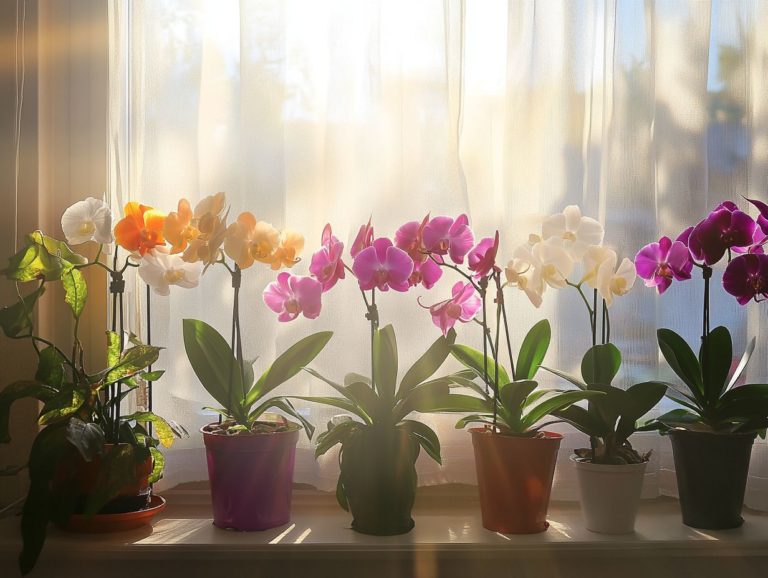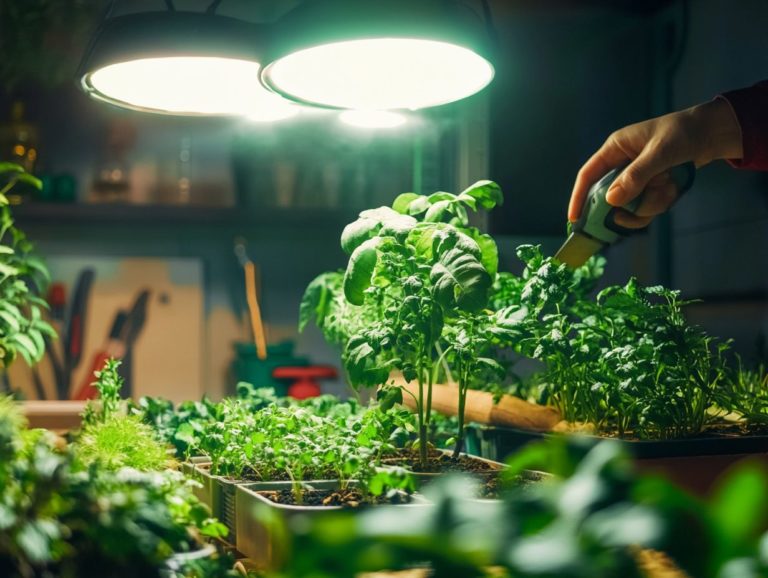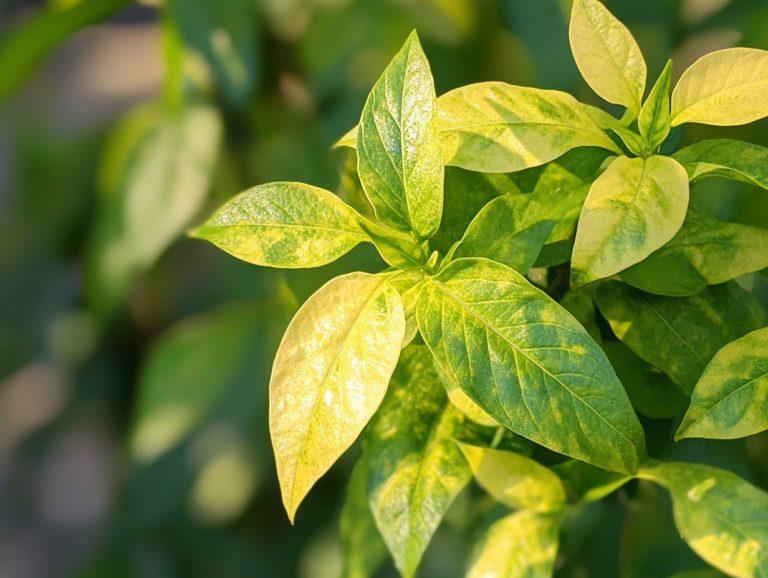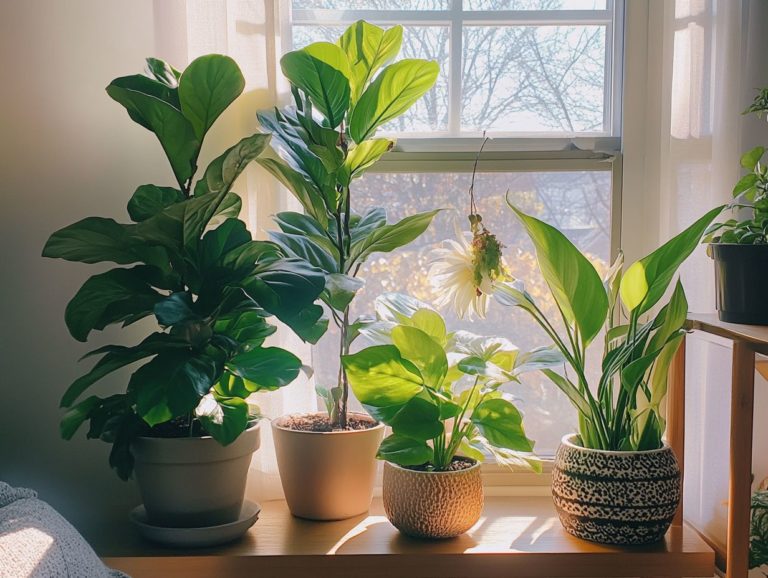The Benefits of Smart Lighting for Plants
In the realm of indoor gardening, smart lighting technology is revolutionizing how you nurture your plants. Don’t miss out! Smart lighting can transform your indoor space into a lush oasis!
By grasping the nuances of how light influences plant growth, the process plants use to convert light into energy, you can harness smart lighting to optimize photosynthesis, boost plant health, and cultivate vibrant greenery.
This article delves into the science of plant lighting, outlines the benefits of smart systems, and guides you in selecting the perfect setup for your vegetables. You’ll find tips for installation and maintenance along the way.
Whether you re just starting out or have years of experience, discover how smart lighting can turn your indoor space into a flourishing botanical haven.
Contents
- Key Takeaways:
- Understanding Smart Lighting for Plants
- The Science Behind Plant Growth and Light
- Photosynthesis and Plant Light Needs
- Benefits of Smart Lighting for Plants
- Optimizing Growth and Health
- Energy Efficiency and Cost Savings
- How to Choose the Right Smart Lighting for Your Plants
- Master the Art of Installations and Maintenance!
- Frequently Asked Questions
Key Takeaways:

- Smart lighting enhances growth and health by providing the right amount and type of light based on specific plant needs.
- This technology saves energy and reduces costs through its efficient use of light.
- When choosing smart lighting, consider factors such as light intensity, wavelength, and duration for maximum benefits.
Understanding Smart Lighting for Plants
Grasping the nuances of smart lighting for plants is crucial for elevating your indoor gardening game. By harnessing advanced technologies like LED grow lights, you can enhance photosynthesis while maximizing energy efficiency.
When you provide the ideal light spectrum tailored to your plants’ specific needs, you can dramatically accelerate growth from seedlings to the vibrant flowering stages. This approach helps you navigate light requirements, temperature regulation, and overall plant health with finesse.
What is Smart Lighting?
Smart lighting encompasses advanced systems and technologies designed to optimize light conditions for your plants. These systems utilize energy-efficient solutions like LED grow lights to enhance plant health and growth cycles.
Imagine having innovative features at your fingertips, such as programmable schedules (automated lighting setups) and smart sensors (devices that adjust light based on environmental changes). By embracing this technology, you can transform your indoor garden into a vibrant oasis while significantly reducing your energy consumption.
Compared to traditional lighting systems, LED grow lights are champions of efficiency, using up to 75% less energy. They deliver the precise wavelengths that your plants need for photosynthesis, promoting healthier growth. This energy efficiency not only helps you save money but also reduces the carbon footprint of your indoor gardening, making it a sustainable choice that aligns with your passion for plants.
The Science Behind Plant Growth and Light
The science behind plant growth and light revolves around the fascinating process of photosynthesis. Here, you ll see how plants harness sunlight and artificial light sources to transform light energy into the chemical energy crucial for their development and health.
Various light spectra are critical in photomorphogenesis the way light affects plant growth shaping growth patterns, enhancing chlorophyll production, and optimizing energy use. This intricate interplay significantly affects flowering processes and overall vitality, making it essential for anyone invested in plant care to understand these dynamics.
Photosynthesis and Plant Light Needs
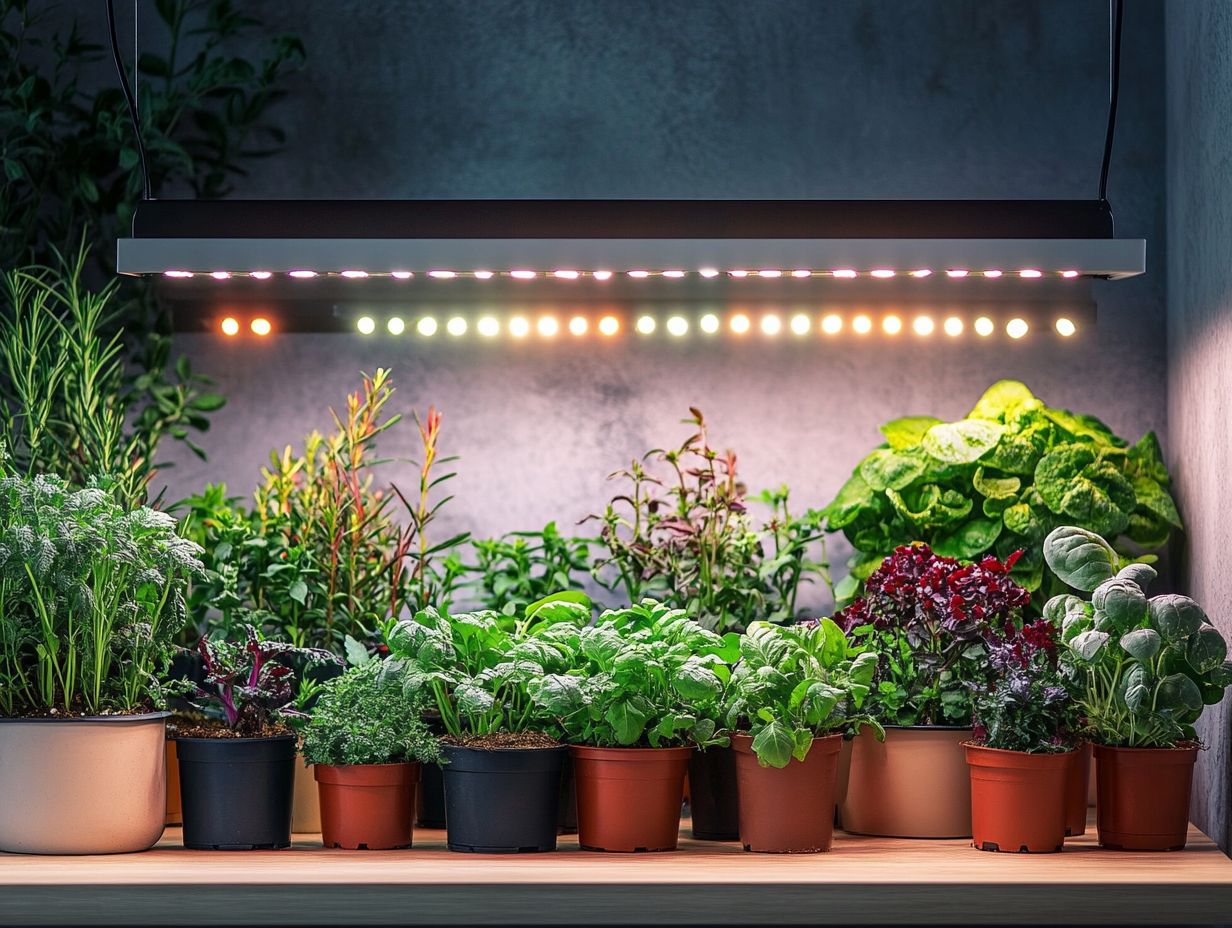
Photosynthesis is the remarkable process by which plants transform light energy into chemical energy. This process relies on specific light wavelengths that activate chlorophyll and maintain overall plant health.
To grasp the nuances of photosynthesis, it s crucial to understand its different phases. The two main phases are light-dependent reactions the first step in photosynthesis that uses sunlight and the Calvin cycle. Each phase depends heavily on particular light spectra. For example, blue light is vital for promoting robust vegetative growth, while red light supports flowering and fruiting stages. If you re an indoor gardener, you must be mindful of these light requirements; insufficient light can lead to stunted growth and a decline in vitality.
Customizing light conditions to meet the specific needs of your plants can significantly elevate the health and productivity of your indoor garden, including options for full spectrum lighting.
Benefits of Smart Lighting for Plants
The advantages of smart lighting for plants are truly remarkable! They elevate both photosynthesis and plant health while ensuring significant energy efficiency in your indoor gardening endeavors.
By harnessing tailored light spectra and the latest technology, including compact fluorescent lamp options, you can create optimal conditions for your plants. This results in vibrant, thriving greenery and enhanced yields.
Optimizing Growth and Health
Optimizing growth and health in your plants can be effortlessly achieved through the strategic use of LED grow lights designed to meet specific light requirements. These lights enhance photosynthesis and overall vitality.
Understanding the varying light needs throughout different growth stages allows you to adjust the intensity and spectrum of these lights effectively. During the seedling phase, use a gentler light setting with a warmer spectrum for sturdy stem development. As your plants transition to the vegetative stage, increase the light intensity and shift to a broader spectrum to support lush foliage growth.
For fruiting and flowering plants like tomatoes and peppers, shifting towards blue, red, or full-spectrum light can significantly boost both yield and quality. Tailoring the light environment not only maximizes growth but also strengthens your plants’ resilience against pests and diseases, setting you up for gardening success!
Energy Efficiency and Cost Savings
Energy efficiency in your indoor gardening is essential for keeping costs manageable. Embracing LED grow lights can enhance both your energy savings and lower running costs.
These remarkable lighting systems convert nearly 90% of electricity into usable light. Traditional options often squander a considerable amount of energy as heat. Imagine transitioning from high-pressure sodium lights to LEDs this shift could lead to a remarkable 50% reduction in energy consumption! Not only will you enjoy substantial savings on your electricity bills, but you’ll also minimize the environmental footprint of your gardening activities.
Numerous studies suggest that investing in LED technology can pay for itself within just a few growing cycles. It’s a savvy choice for both hobbyists and commercial growers who want to cultivate efficiently while being mindful of their budgets and the planet. For optimal results, consider these tips for effective plant lighting.
How to Choose the Right Smart Lighting for Your Plants
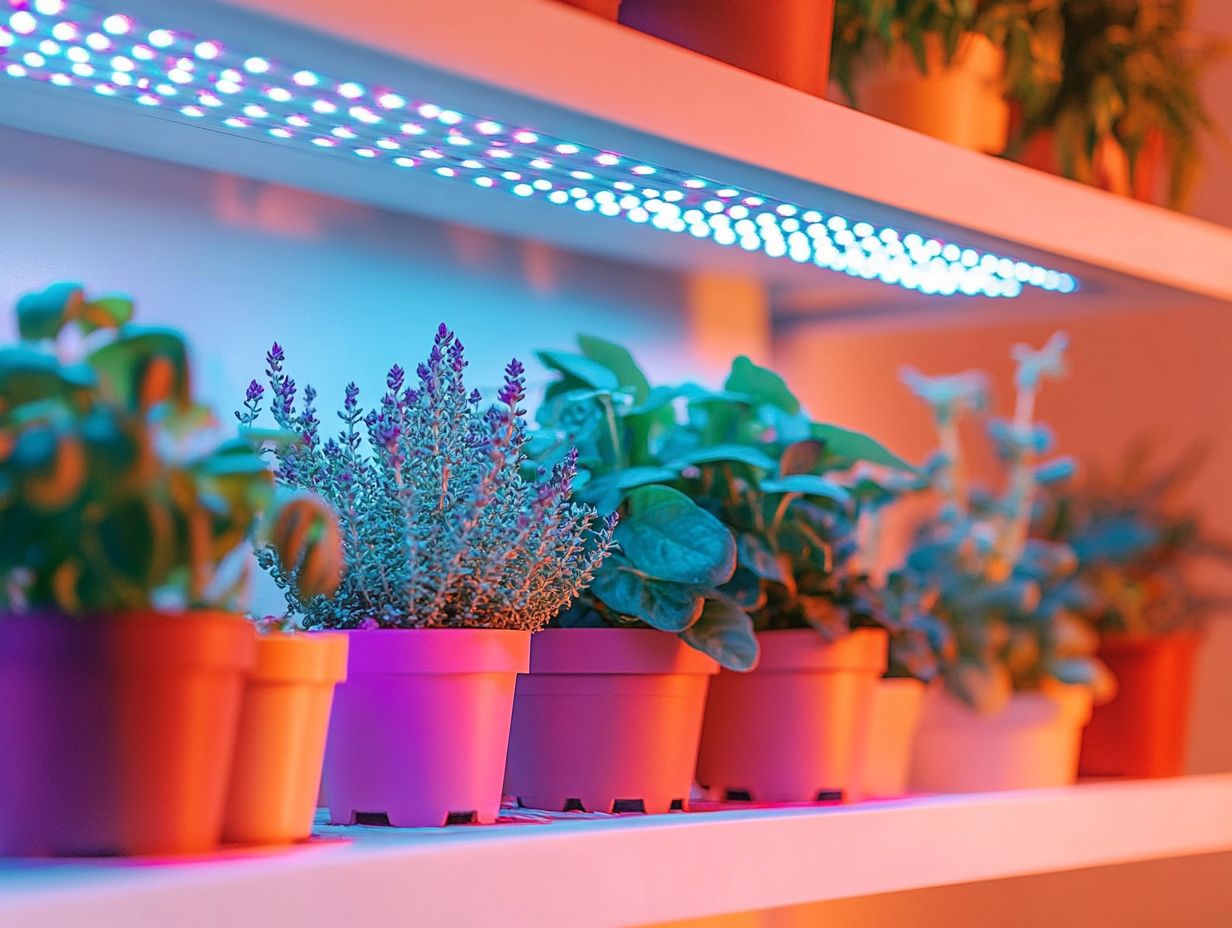
Selecting the ideal smart lighting for your plants requires a keen understanding of their unique light spectrum requirements. By considering energy-efficient lighting options, you can enhance their growth and overall health, creating an optimal environment for flourishing greenery.
Don’t wait! Discover how smart lighting can transform your garden today! Start optimizing your indoor garden now for beautiful plants!
Factors to Consider
When selecting smart lighting, consider several key factors, including the type of LED grow lights, their light spectrum, and how these elements impact plant growth and health.
The specific plant species you re cultivating is crucial in tailoring your lighting setup. Different plants have unique light requirements. For example, flowering plants need a different spectrum compared to leafy greens during various growth stages.
By understanding these requirements, along with the dimensions and height of your growing area, you can significantly enhance the effectiveness of your chosen lighting.
Some LED options even offer adjustable spectrum, including options for AeroGarden setups. This allows you to customize the light conditions as your plants progress from germination to maturity. For enhanced care, consider using smart lights for plant care, ensuring optimal health and yield throughout their lifecycle.
Master the Art of Installations and Maintenance!
The proper installation and maintenance of smart lighting systems, especially LED grow lights, are essential for optimal plant health and maximizing growth potential in your indoor gardening endeavors.
By paying careful attention to these aspects, you create the ideal environment for your plants to thrive.
Proper Setup and Care for Maximum Results
Achieving maximum results with LED grow lights requires a thoughtful setup and diligent care. This ensures your plants receive the perfect light spectrum tailored to their growth stages.
The arrangement of your lights is crucial; positioning them at the optimal distance from the plants will help avoid issues like burning or inadequate coverage.
During the early growth stages, shorter light exposure allows your seedlings to develop strength without overstimulation. As your plants mature, adjust both the intensity and duration of the lighting to align with their evolving needs for optimal photosynthesis.
This attentive management cultivates healthier, more vigorous plants. It also boosts their resilience against pests and diseases, ultimately leading to generous yields.
Frequently Asked Questions
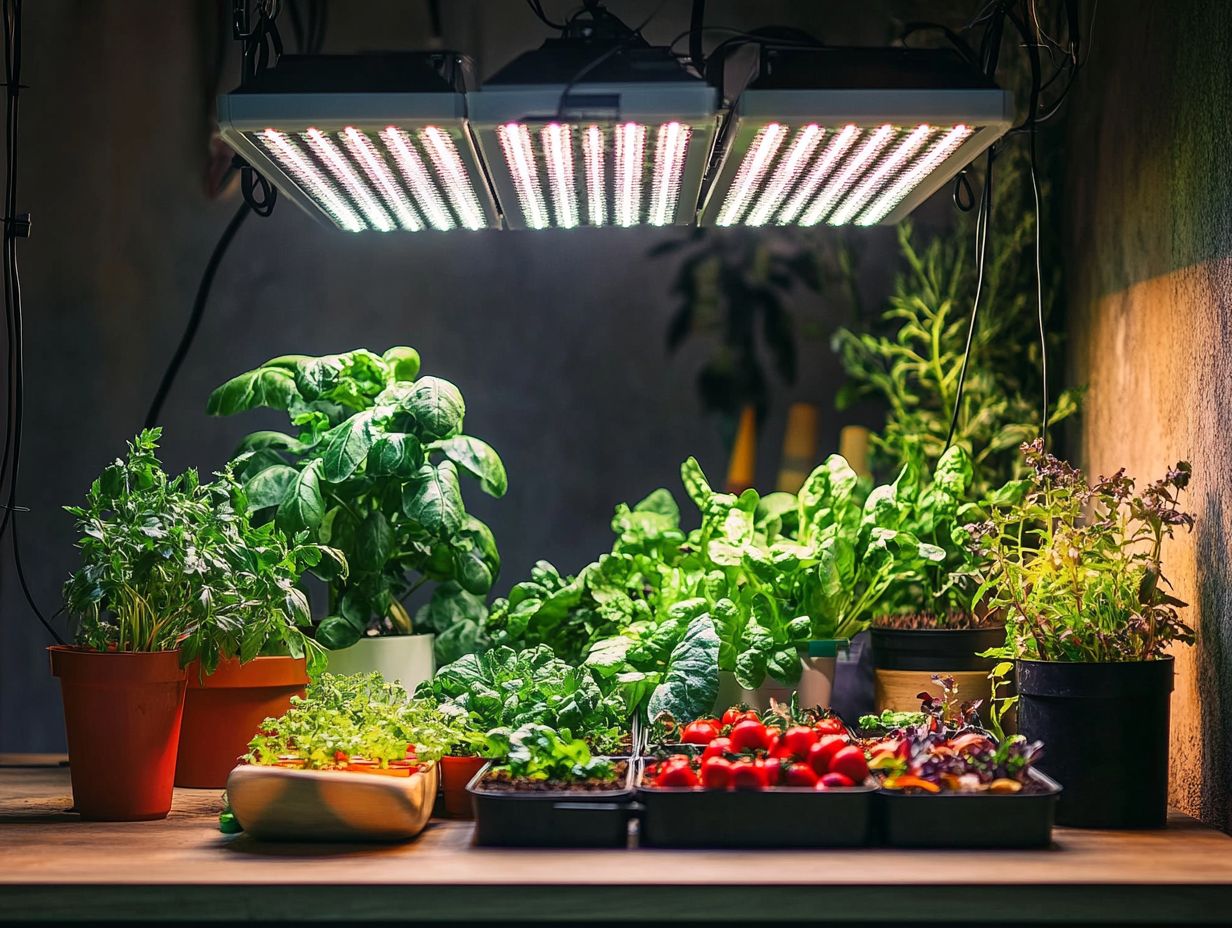
What are the benefits of using smart lighting for plants?
Smart lighting provides the necessary light spectrum and intensity to promote healthy growth, resulting in larger, stronger, and more vibrant plants.
How does smart lighting save energy and reduce costs?
Smart lighting systems can be programmed to turn off when natural light is available or when plants do not require much light. This leads to energy efficiency and cost savings.
What types of plants can benefit from smart lighting?
All types of plants, from succulents to flowering plants to leafy greens, can benefit from smart lighting as it meets the specific light requirements for each type.
Is it easy to set up and use smart lighting for plants?
Yes, most smart lighting systems come with user-friendly interfaces and can be easily controlled with a smartphone app, making it convenient for any indoor gardener.
Are there additional benefits of using smart lighting for plants?
Smart lighting can improve the overall aesthetic of indoor spaces, providing a soothing and inviting atmosphere while promoting plant growth.
Explore various smart lighting options to transform your indoor gardening experience!

